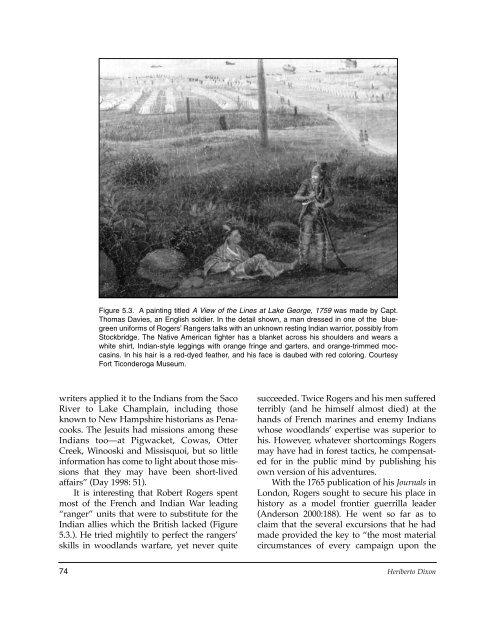Mohican Seminar 2 The Challenge - New York State Museum - New ...
Mohican Seminar 2 The Challenge - New York State Museum - New ...
Mohican Seminar 2 The Challenge - New York State Museum - New ...
Create successful ePaper yourself
Turn your PDF publications into a flip-book with our unique Google optimized e-Paper software.
Figure 5.3. A painting titled A View of the Lines at Lake George, 1759 was made by Capt.<br />
Thomas Davies, an English soldier. In the detail shown, a man dressed in one of the bluegreen<br />
uniforms of Rogers’ Rangers talks with an unknown resting Indian warrior, possibly from<br />
Stockbridge. <strong>The</strong> Native American fighter has a blanket across his shoulders and wears a<br />
white shirt, Indian-style leggings with orange fringe and garters, and orange-trimmed moccasins.<br />
In his hair is a red-dyed feather, and his face is daubed with red coloring. Courtesy<br />
Fort Ticonderoga <strong>Museum</strong>.<br />
writers applied it to the Indians from the Saco<br />
River to Lake Champlain, including those<br />
known to <strong>New</strong> Hampshire historians as Penacooks.<br />
<strong>The</strong> Jesuits had missions among these<br />
Indians too—at Pigwacket, Cowas, Otter<br />
Creek, Winooski and Missisquoi, but so little<br />
information has come to light about those missions<br />
that they may have been short-lived<br />
affairs” (Day 1998: 51).<br />
It is interesting that Robert Rogers spent<br />
most of the French and Indian War leading<br />
“ranger” units that were to substitute for the<br />
Indian allies which the British lacked (Figure<br />
5.3.). He tried mightily to perfect the rangers’<br />
skills in woodlands warfare, yet never quite<br />
succeeded. Twice Rogers and his men suffered<br />
terribly (and he himself almost died) at the<br />
hands of French marines and enemy Indians<br />
whose woodlands’ expertise was superior to<br />
his. However, whatever shortcomings Rogers<br />
may have had in forest tactics, he compensated<br />
for in the public mind by publishing his<br />
own version of his adventures.<br />
With the 1765 publication of his Journals in<br />
London, Rogers sought to secure his place in<br />
history as a model frontier guerrilla leader<br />
(Anderson 2000:188). He went so far as to<br />
claim that the several excursions that he had<br />
made provided the key to “the most material<br />
circumstances of every campaign upon the<br />
74 Heriberto Dixon
















